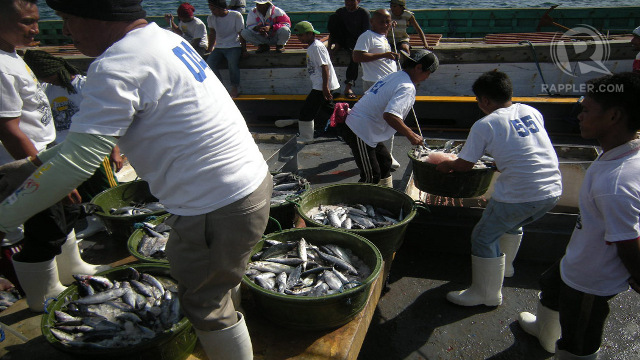SUMMARY
This is AI generated summarization, which may have errors. For context, always refer to the full article.

GENERAL SANTOS CITY, Philippines – Total fish landings at the country’s biggest fishing port complex rose 23.7% in 2012 from the previous year, according to the data released by the General Santos City office of the Philippine Fisheries Development Authority (PFDA) on Tuesday, March 26.
A total of 139,613.34 metric tons of fish, mostly tuna, were landed at the fish port complex here last year, up from 112,890.81 metric tons in 2011.
The biggest gainer was Market 1, where big yellowfin tuna are landed. It recorded a catch of 12,701.04 metric tons, the first time in 5 years that catch hit 5 figures. The figure was a hefty 105% increase over the low of 6,185.94 landings in 2011.
Also gaining was Market 2 with an increase of 48% in landings. A total of 48,455.43 tons were landed in Market 2, an increase of 15,708.84 tons over 2011’s 32,746.59. Medium-size purse seine operators and municipal fishermen bring their catch here. Aquaculture production are likewise landed in this market.
Market 3, where big tuna catch are landed, also posted a hefty 65% hike in total catch with a record of 15,024.08 tons in 2012, against 9,061.13 tons in 2011.
Foreign tuna landings at Wharf 1 posted a slight increase to 56,108.23 from 53,101.04 metric tons in 2011.
Bucking the trend was Wharf 2, where frozen tuna from Manila are landed. Only 7,324.56 tons were landed at Wharf 2 in 2012 compared to the 11,796.11 tons in 2011.
The figures did not include landings at other fishing ports in the country. The General Santos City Fish Port figures also did not include landings at private wharves in the city. Among the big fishing companies that operate their private wharves are RD Fishing, TSP Marine and Frabelle Fishing.
Closure of tuna fishing grounds
Bureau of Fisheries and Aquatic Resources (BFAR) director Asis Perez attributed the increase to ongoing management of tuna stocks and other fish species in the country’s fishing grounds.
He recently said that 10% of the increase in tuna catch may also be attributed to the sardine fishing closure in the Zamboanga Peninsula, Sulu Sea and Basilan Straits.
“We are looking at the scientific correlations of the closure to the 10% increase in local tuna catch and landings (also last year),” Perez said during the ceremonial lifting of the sardine fishing closure season in Zamboanga City earlier this month.
The increase in total tuna landings also came a year after the two-year closure of two pockets of high seas in the Western and Central Pacific to tuna FAD fishing.
FADs (fish aggregating devices) are floating and anchored structures designed to attract small fish.
The Philippines also complies with the 4-month annual ban on FAD fishing within its territorial waters beginning the month of July.
In March last year, the Western and Central Pacific Fisheries Commission (WCPFC) lifted the ban on FAD fishing in Pocket 1 High Seas, an area of about 590,000 square kilometers east of Indonesia and north of Papua New Guinea, exclusively for Philippine tuna catchers.
The Philippines is a member of WCPFC and signatory to various conservation measures adopted by the world’s largest tuna fishing regulatory commission. – Rappler.com
Add a comment
How does this make you feel?
There are no comments yet. Add your comment to start the conversation.